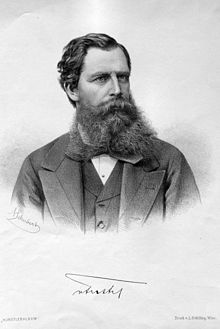Heinrich von Ferstel
| Heinrich von Ferstel | |
|---|---|

Heinrich von Ferstel (circa 1880)
|
|
| Born |
Johann Heinrich Ferstel 7 July 1828 Vienna, Austrian Empire |
| Died | 14 July 1883 (aged 55) Grinzing (present-day Vienna) |
| Nationality | Austrian |
| Occupation | Architect |
| Spouse(s) | Lotte Ferstel née Fehlmann |
| Children | Max von Ferstel, Marianne von Ferstel |
| Awards |
|
| Buildings | |
Heinrich Freiherr von Ferstel (7 July 1828 – 14 July 1883) was an Austrian architect and professor, who played a vital role in building late 19th-century Vienna.
The son of Ignaz Ferstel (1796–1866), a bank clerk and later director of the Austrian national bank in Prague, Heinrich Ferstel, after wavering for some time between the different arts, finally decided on architecture. From 1847 he studied at the Academy of Fine Arts Vienna under Eduard van der Nüll and August Sicard von Sicardsburg. After several years during which he was in disrepute because of his part in the 1848 Revolution, he finished his studies in 1850 and entered the atelier of his uncle, Friedrich Stache, where he worked at the votive altar for the chapel of St. Barbara in St. Stephen's Cathedral, Vienna and co-operated in the restoration and construction of many castles, chiefly in Bohemia. Journeys of some length into Germany, Belgium, Holland, and England confirmed him in his tendency towards Romanticism. It was in Italy, however, where he was sent as a bursar in 1854, that he was converted to the Renaissance style of architecture, and his admiration for Bramante. He began to use of polychromy by means of Graffito decoration and terracotta. This device, adapted from the Early Renaissance and intended to convey a fuller sense of life, he employed later in the Austrian Museum of Applied Arts.
While still in Italy he was awarded the prize in the competition for the Votive Church (Votivkirche) in Vienna (1855) over 74 contestants. He built it between 1856-79. After his death it was proposed by Sir Tatton Sykes as a model for the new Westminster Cathedral in London. Another of Ferstel's monumental works belonging to the same period is the Austro-Hungarian bank in Vienna, in the style of the Early Renaissance (1856–60). The expansion of the city of Vienna enabled Ferstel, with Rudolf Eitelberger, to develop civic architecture along artistic lines (Burgomaster's residence, Stock Exchange 1859). At the same time he had also the opportunity of putting his ideas into practice in a number of private dwellings and villas in Brünn and Vienna.
...
Wikipedia
